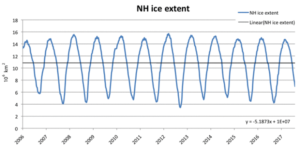by Kenneth Richard, August 7, 2017 in NoTricksZone reposted Paul Homewood
In recent months, two new papers published in The Cryosphere have provided a condensed summary of the ice-melt and sea-level-rise consequences of global warming for the Arctic region.
1. Between 1900 and 2010, the Greenland Ice Sheet (GIS) has melted so extensively and so rapidly that the GIS ice-melt contribution to global sea level rise has amounted to 1.5 centimeters for the entire 110-year period. One-and-a-half centimeters. That’s 0.59 of an inch!
2. It gets worse. Between 1993 and 2010, the contribution to global sea level rise has been a disturbing 0.39 of a centimeter. Almost 4/10ths of a centimeter. That’s 0.15 of an inch!


